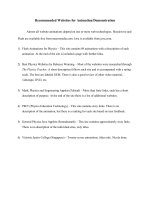Tài liệu WINNING Basketball For Girls pot
Bạn đang xem bản rút gọn của tài liệu. Xem và tải ngay bản đầy đủ của tài liệu tại đây (7.57 MB, 189 trang )
WINNING
BASKETBALL
For GIrls
The Winning Sports for Girls Series
Winning Basketball for Girls, Fourth Edition
Winning Lacrosse for Girls, Second Edition
Winning Soccer for Girls, Third Edition
Winning Softball for Girls, Second Edition
Winning Track and Field for Girls, Second Edition
Winning Volleyball for Girls, Third Edition
BASKETBALL
Faye Young Miller
Wayne Coffey
Fourth Edition
WINNING
BASKETBALL
For GIrls
WINNING BASKETBALL FOR GIRLS, Fourth Edition
Copyright © 2009, 2002, 1992 by Faye Young Miller and Wayne Coffey
All rights reserved. No part of this book may be reproduced or utilized in any form
or by any means, electronic or mechanical, including photocopying, recording, or by
any information storage or retrieval systems, without permission in writing from the
publisher. For information contact:
Chelsea House
An imprint of Infobase Publishing
132 West 31st Street
New York NY 10001
Li
brar
y of Congress Cataloging-in-Publication Data
Miller, Faye Young.
Winning basketball for girls / Faye Young Miller, Wayne Coffey. — 4th ed.
p. cm. — (Winning sports for girls series)
Includes index.
ISBN-13: 978-0-8160-7759-5 (hardcover : alk. paper)
ISBN-10: 0-8160-7759-2 (hardcover : alk. paper)
ISBN: 9780816077595 (e-book)
1. Basketball for girls. I. Coffey, Wayne R. II. Title.
GV886.M48 2009
796.323082—dc22 2008039752
Chelsea House books are available at special discounts when purchased in bulk
quantities for businesses, associations, institutions, or sales promotions. Please call
our Special Sales Department in New York at (212) 967-8800 or (800) 322-8755.
You can find Chelsea House on the World Wide Web at
Text design by Erika K. Arroyo
Cover design by Alicia Post
Photos by Patrick Shanahan, unless otherwise noted
Illustrations by Accurate Art
Printed in the United States of America
Bang Hermitage 10 9 8 7 6 5 4 3 2 1
This book is printed on acid-free paper.
All links and Web addresses were checked and verified to be correct at the time of
publication. Because of the dynamic nature of the Web, some addresses and links may
have changed since publication and may no longer be valid.
To my husband, Matthew Peter Miller,
my son, Samuel Peter, and my daughter, Chaney
Elizabeth, with love and in memory of my mother
Irene, who always made sure I got the chance to play.
To my former teammates—at Bunn High School,
Peace College, North Carolina State University,
and in the Women’s Professional Basketball League
(WBL)—the New York Stars and
the New Jersey Gems.
And to my former players—Fairview High School,
Manhattan College, Georgia Tech,
Ithaca High School, Upstate Ladies (AAU),
Cornell University, and Cortland State.
Lastly to my former coaches—my love for this game
is a direct result of your sharing it with me.
Much love.
—F. Y. M.
In loving memory of my grandparents, and for
Mr. and Mrs. Edward J. Willi, Sr., who are
my grandparents too.
—W. C.
wQ t A i j opS d Tk P
Enthusiasm is the electricity of life. How do you get it? You act
enthusiastic until you make it a habit. Enthusiasm is natural;
it is being alive, taking the initiative, seeing the importance of
what you do, giving it dignity and making what you do impor-
tant to yourself and to others.
—Gordon Parks, author and film director
It is not the critic who counts; not the man who points out how
the strong man stumbles, or where the doer of deeds could have
done them better. The credit belongs to the man who is actually
in the arena, whose face is marred by dust and sweat and blood,
who strives valiantly; who errs and comes short again and again;
because there is not effort without error and shortcomings; but
who does actually strive to do the deeds; who knows the great
enthusiasms, the great devotions, who spends himself in a wor-
thy cause, who at the best knows in the end the triumph of high
achievement and who at the worst, if he fails, at least he fails
while daring greatly, so that his place shall never be with those
cold and timid souls who know neither victory nor defeat.
—Theodore Roosevelt, 26th President of the United States
w Q t A i j o S d k P
wQ t A i j opS d Tk P
ACKNOWLEDGMENTS ix
INTRODUCTION xi
LEGEND FOR
ILLUSTRATIONS xvii
1 A
LOOK AT THE GAME 1
2 GETTING STARTED 7
3 PREPARATION FOR SUCCESS—GETTING IN SHAPE 11
4 BALL-HANDLING—DEVELOPING A FEEL FOR THE BALL 28
5 FOOTWORK—THE FOUNDATION OF
GOOD BA
SKETBALL 34
6 YOUR BEST SHOT 43
7 PASSING—THE HEART OF THE GAME 65
8 DRIBBLING UNDER CONTROL 78
9 DEVELOPING INDIVIDUAL OFFENSIVE SKILLS 91
CONTENTS
10 WORKING TOGETHER—TEAM OFFENSE 102
11 PLAYING TOUGH DEFENSE 117
12 UNDER THE BOARDS—HOW TO GET REBOUNDS 136
13 ALL ABOUT ZONES 147
14 PARTING THOUGHTS 155
GLOSSARY 158
BASKETBALL RESOURCES 162
INDEX 164
w Q t A i j o S d k P
wQ t A i j opS d Tk P
ACKNOWLEDGMENTS
Thanks to my sisters—Margie, Cathy, and Kaye—for their love and
support.
Thanks to my Ithaca models—Taylor, Molly, Dacia, Katie, Jocelyn,
and my daughter Chaney—all young players we can expect to see on the
court.
Thanks to some awesome coaches for their quotes used to introduce
the chapters.
Special thanks to Thomas Howley, assistant athletic director for ath-
lete performance and head of strength and conditioning coach at Cornell
University, for sharing his expertise in the “Preparation for Success—
Getting in Shape” chapter.
Special thanks, too, to Patrick Shanahan, photographer, for his
patience and excellence in getting the photos taken.
Thanks to Wayne Coffey for his collaboration in the very first Winning
Basketball for Girls. His writing expertise and early efforts to get this book
started is still greatly appreciated.
Lastly, thanks to Facts On File, especially to James Chambers, for
publishing this book!
—F. Y. M
.
Very special thanks to my brother, Frank, an estimable basketball coach
and mentor, who taught me the finer points of shooting lay-ups and
sneaking into gyms; to the girls of the Horace Mann basketball teams
(1979–83), who made basketball season a very special and much-awaited
time; to Faye Young Miller, who was as cooperative as a collaborator as
she was committed to making this book the best of its kind; and to Gerry
Helferich, whose care and deft editorial hand were the book’s shaping
forces from the outset.
—W. C.
ix
Thom O’Connor
INTRODUCTION
Women’s basketball hasn’t grown. It has exploded. In the last four decades,
the number of girls playing interscholastic basketball has skyrocketed.
Youth leagues have sprung up everywhere. The number of summer camps
seems to double annually. More and more colleges are developing big time
programs, and girls are playing at younger ages than ever before. More
players are being recruited to play in college, and there are more profes-
sional opportunities for players after college. In addition, more women
officiate and coach at all levels. Is it any wonder that players are getting
better and better and, as a result, getting more media exposure?
I’ve experienced the game’s progress firsthand. When I started playing,
some 40 years ago, women’s basketball bore little resemblance to what we
see today. There were six players to a side—two on offense, two on defense,
and two rovers. Only the rovers were free to roam all over the court. The
other four players had to stay in their designated offensive or defensive
area, a rule that did little to encourage all-around basketball skills. Worse
still, in some parts of the country you were allowed only two dribbles
before getting rid of the ball. Fortunately, the powers that be finally saw
the folly in such a setup, and in 1971 a rule was passed allowing girls to
play under rules which are more comparable to the ones the guys play
under. The women’s game has been booming ever since.
It “boomed” for me right from the start, which was in seventh grade
on my junior high school team in Bunn, North Carolina. It was the first
time the school had a team, and the coach was scouting the corridors and
classrooms for possible recruits. He took one look at my twin sister, Kaye,
and me, noted we were 5-foot-7 (pretty tall for seventh-graders), and asked
u
s t
o try out. We did, and for both of us, it was love at first shot . . . and
dribble . . . and pass. . . . We went 8-0 that season, and Kaye and I haven’t
strayed far from the hard-wood since.
I practiced two to three hours a day, year round, right through high
school, college, and the pros. Being dedicated was easy for me; not only
was it what I wanted to do, we also had a terrific high school team, and
I badly wanted to keep that tradition going. Maybe you’ve gotten hooked
xi
wQ t A i j opS d Tk P
xii Winning Basketball for Girls
right away, as I did. Or maybe your interest has come along more slowly.
Whether you’re an eager beginner or a seasoned high school veteran, you
must have the basketball bug by now if you’re reading this book, and I
think that’s great. The more girls that play, the better the women’s game
will get. And that’s only good for all of us, players and coaches alike.
I’ve written this book with two aims: one, to give you specific, straight-
forward instruction—pointers and drills for improving every facet of your
game; and two, to “talk” basketball with you in a broad sense, in a way
that’ll give you a better feel for the reasons behind what you’re doing on the
court. My years of coaching and playing have convinced me that in basket-
ball the “whys” are as important as the “hows.” You’ll often hear coaches
talk about “muscle memory”—constantly repeating a particular drill until
your body is programmed to perform it correctly. That’s valuable, no doubt
about it. But it’s even more valuable when the movement is explained, so
you understand why it’s so important to execute it in that way. We could
spend a practice session working on how to dribble, and it would be time
My sister Kaye and I were cocaptains of North Carolina State (1977–78), the
state champion and third-ranked team in the nation. (That’s me, bottom row,
third from the right.) North Carolina State University Sports Information Department
xiii
Introduction
well spent. So much the better, though, when we talk about the dribble
as an offensive weapon, and where and when it should (and shouldn’t) be
used. Such insights will increase your feel for the game, and that’s impor-
tant. The best players aren’t those who go out there with a mechanical,
do-this, do-that approach, but those who develop a court sense of how and
when to move and react on the floor in different situations.
The point is that getting to know the game better as you learn to play
it better will make a huge difference in your rate of improvement. So will
having the right attitude.
Any coach can tell you how important attitude is to a player’s develop-
ment. One of the biggest frustrations for a coach is having a talented player
who, for whatever reason, doesn’t concentrate or push herself to improve.
One of the greatest satisfactions, on the other hand, is seeing a girl of
limited natural talent work hard to become the best basketball player she
can be. The way you approach the game will have a big effect on how well
you play it.
BE ENTHUSIASTIC
In this book, we’ll talk a lot about working hard and improving, but don’t
forget that the most important guideline of all is to enjoy yourself when
you’re playing. That, presumably, is why you picked up the ball in the first
place, and why you’re continuing to play. This book is intended to be a
means to that end. After all, the better you play, the more fun it’ll be.
As long as basketball is fun, you’ll naturally be enthusiastic about it,
and that makes any experience more fulfilling. Show enthusiasm when
y
ou
play. Play with spirit. Congratulate your team-mate when she makes a
nice play. Support the others and pick them up when they’re down. Praise
unselfish play—the pass or the screen that can easily go unnoticed. Say
“Nice try” if a teammate attempts a move that doesn’t work out as planned.
Admit your mistake when you’ve missed an open player or made a bad
play. Don’t bad-mouth other players, grumble about practice, or complain
publicly about the coach. If you’re not enjoying yourself or you feel as
though you’re being mishandled, talk to your coach about it. She’ll want
to know.
You don’t have to be a full-time cheerleader. Not everybody is suited
to the rah-rah stuff. Enthusiasm is a state of mind. And the best thing
about it—besides how much it enhances your enjoyment—is what it does
for others. Enthusiasm is contagious. It can spread through a team in no
time. It’ll keep everybody closely knit, foster a spirit of cooperation, and
lift you up when you’re not having one of your more memorable practices
or games.
xiv Winning Basketball for Girls
If you’ve played on a team where enthusiasm was the watchword, none
of this is news to you. If you haven’t, please take it on faith that being
positive and showing enthusiasm will make your basketball experiences
infinitely more rewarding—as a player and as a person. “Nothing great
was ever achieved without enthusiasm,” said Ralph Waldo Emerson. No
argument here.
WHAT’S NEW
Since the initial publication of Winning Basketball for Girls, women’s
basketball has grown at an even higher rate. Playing opportunities at
the upper levels of basketball—the WNBA, national teams, and college
programs—have increased dramatically. Title IX has continued to create
more opportunities for women to play collegiate basketball, often on ath-
letic scholarship. This means that high school players have more motiva-
tion than ever to play at higher levels. Due to a “trickle down” effect, girls
at the middle and elementary school levels have started to play and com-
pete earlier than ever before. Amateur Athletic Union (AAU) competition
and summer basketball camps give young players further opportunities to
develop.
This new edition was updated with these changes in mind. Basketball,
the game, hasn’t really changed much, but since the stakes are higher, it
has become even more important to develop solid fundamentals at an
early age. Learning the fundamentals the right way the first time is a great
idea. It is much harder to break bad habits and relearn skills. To play the
game, you must be comfortable handling the ball. You must be comfort-
able shooting and passing. You must be able to move efficiently—to jump,
to run, to rebound, to start and stop, to change direction, to defend. You
need to grasp concepts such as spacing and court balance. You need to
understand individual and team defense. New photos and illustrations
have also been added to provide a more up-to-date backdrop for explain-
ing fundamental skills and techniques. In addition, the “Getting in Shape”
chapter has been rewritten with new information, photos, and illustrations
to help you to get ready to play. Preparing your body for each practice or
workout and for each game and season is critical to help you play your very
best and to help you stay on the court by preventing or limiting injuries.
Most of all, you must love what you do. Basketball requires commit-
ment, passion, and hard work. The team must be bigger than the indi-
vidual. BIG TEAM, little me. You must be accountable to your teammates
and you need to expect them to be accountable. And, you must commu-
nicate—on and off the court. “We are [insert team name], we are one!”
Believe it!
xv
Introduction
You will find other minor changes that reflect my evolving perspective.
I feel differently about the game than I did when the book was first pub-
lished. I’ve played, coached, color-commentated, and officiated, and now
I
’v
e watched my children as they go through the world of athletics. Things
look and feel different. I see the game in a whole new way.
As a player, and as a coach, enjoy the little things. Sure, winning is
fun but it’s not the ultimate goal. Playing, competing, growing, establising
relationships, developing—enjoy it all!
Now, let’s hit the court.
—Faye Young Miller
Ithaca, New York
Thom O’Connor
LEGEND FOR
ILLUSTRATIONS
Note: Throughout the text, players and coaches will be referred to as she
or her. This is done only to simplify the writing. I have worked with so
many awesome male coaches—no slight intended.
Also, I hope some young male players will read this book!
1
1
A Look at
the Game
“Be strong in body, clean in mind, lofty in ideals”.
—Dr. James Naismith, the father of basketball
J S, M,
physical-education instructor named Dr. James Naismith was looking for
a game that could be played indoors in the cold winter months. He fas-
tened two peach baskets to the gymnasium balcony and told his students
to try throwing a soccer ball into the baskets. Thus was basketball born.
In the game’s infancy, there were no backboards. No dribbling was
allowed, and seven persons played on a team. There wasn’t even an open
basket; a person had to sit atop a ladder to pull the ball out of the basket
and toss it back down to the players. Gradually changes and refinements
were made until the game evolved into the one we know today. Let’s get
a quick overview of that game before we go into our deeper discussion of
specific skills and instruction.
THE COURT
Most high school basketball courts are 84 feet long by 50 feet wide. College
courts are the same width, but 94 feet long. A basket, consisting of a rim (a
steel hoop 18 inches in diameter and 10 feet from the ground) and a back-
board (a rectangular piece of Plexiglas or wood measuring 42 x 72 inches),
is located at either end of the playing area.
2 Winning Basketball for Girls
Figure 1-1
3
A Look at the Game
The court is divided by a midcourt line, and is marked off by baselines
(at each end of the court) and sidelines, as shown in Figure 1-1. Fifteen feet
out from the backboard are the free throw or foul lines, where a player
shoots an uncontested shot after an opponent commits a foul.
A 12-foot-wide area between the foul line and the basket (it’s usually
painted) is known as the “key,” free throw lane, or three second area, so
named for a rule that prohibits any offensive player from staying in it for
more than three seconds at a time. The free throw lane is marked off on
the sides with spaces three feet wide, used for the non-shooters to line up
when a free throw is taken. The first occupied spaces—left and right—clos-
est to the hoop are for the non-shooting team. At the center of the court is
a jump circle, where the official tosses up the ball to start the game.
THE PLAYERS
Basketball is played by two teams of five players each. The basic positions
include a center, two forwards, and two guards. Traditionally, the offensive
positions are numbered and broken down as follows:
T
hen No
w
1. Point Guard Point Guard
2. Shooting Guard Perimeter #2
3. Small Forward Perimeter #3
4. Power Forward “Big”/post
5. Center “Big”/post
Today, players do not always fit the traditional roles regarding posi-
tions. Players must be versatile. All players must develop shooting—inside
and outside, ballhandling, and the footwork skills to play today’s game.
Different offensive sets require different positions. Some teams play a
4-out, 1-in pattern, some play a 3-out, 2-in and some play a motion offense
with players switching positions during the offensive possession. Some
teams play all 5 players on the perimeter—dribble drive motion style.
Many of today’s college teams introduce their players as post—2 “bigs” as
we call them and 3 perimeter players. The point guard is still somewhat
defined as the primary ball handler and the “playmaker” while the other
perimeter players can be interchanged. Traditionally, the guards or perim-
eter players set up farthest away from the basket. They are usually quick
and agile players who are good at handling the ball, shooting from range
and passing the ball. On many teams, one player is still designated as the
point guard, who handles the ball most of the time and is the “quarter-
back” of the offense. The other guard is called the shooting guard and is
4 Winning Basketball for Girls
relied on for perimeter shooting and passing. Having the ability to shoot
the three-point shot—taken from behind the semicircular line drawn 19
feet, 9 inches from the basket—gives the perimeter players an added offen-
sive weapon, and opens up the inside area when the defense has to move
out to defend against the three.
The forwards, sometimes known as the wings, play outside the lane
usually to the sides of the basket, sometimes at the free throw lane
extended. Depending on the team offense, the power forward may post
up around the lane with her back to the basket, and the small forward
may pop out wide on the baseline facing the hoop. Both forwards have to
rebound.
The center, sometimes the tallest and most powerful player, generally
stays closer to the basket than the other players, setting up in the area of
the free- throw lane. If the center is positioned near the free throw line,
she’s known as a high post; if she’s positioned close to the baseline, in the
first lane space area “on the block,” she’s known as a low post. The center
typically plays with her back to the basket before receiving the ball and she
has to be a good rebounder and passer.
The more skills you develop, regardless of your position, the more time
you will be on the floor. Again, being able to do many things well, being
versatile, will get you in the game! Don’t limit yourself or allow others to
limit you, based on your size or speed. Learn to handle, learn to shoot, and
play tough defense. It is especially important for you to handle the ball as
a young player. You will make mistakes, dribble off your foot or whatever,
but you will learn by doing, and you will get better.
HOW THE GAME IS PLAYED
The team with possession of the ball is known as the offensive team; the
other is the defensive team. Points are scored by shooting the ball into the
basket being defended by the opposing team. Each team can score only by
shooting at the opponent’s basket, which is why the game flows up and
down the court.
Two or three points are awarded for a successful shot, depending upon
where it’s taken from. These shots are called field goals. To get credit
for three points, a player must be behind the three-point line when she
releases the ball or leave the floor from behind the line if she is airborne.
Again, the three-point line is 19 feet, 9 inches from the hoop. One point
is awarded for a successful free throw, or foul shot, a shot taken from the
free throw line after a foul by an opposing player. Not all fouls result in
free throws, however. To go to the line, a player must be fouled in the act
5
A Look at the Game
of shooting, or fouled intentionally. The other instance when free throws
are taken is when the defensive team has surpassed its allotted number of
fouls—over the limit, as it’s called. When one team fouls seven times in a
half, the other team is allowed a one plus one opportunity. If the shooter
makes the first, she gets a second shot. If a team has fouled 10 times, the
opponent gets a double bonus, or two shots. When a player is fouled from
behind the three-point line, she gets to shoot three free throws if the field
goal is missed. A successful field goal and a foul result in one free throw,
regardless of where the shot is taken. Common fouls include pushing,
blocking, holding, and hitting a player’s arm as she’s shooting. After five
fouls, a player is disqualified from the game.
Common sense tells us that the closer to the basket a shot is attempted,
the better the chances that it will go in. The objective of the offensive team
is to advance the ball so as to get the best shot that it can. There are only
two ways the ball can be advanced—passing (throwing it from one player
to another) or dribbling (bouncing the ball as you move in any direction).
The defensive team’s objective is to protect the basket by keeping the
offense as far from it as possible. Ideally, the defensive team wants to stop
the offense from even attempting a shot. The next best thing is forcing
them to take a difficult or low-percentage shot.
Whenever a shot is missed, players on both teams compete to get the
rebound. Once the defensive team gets possession of a rebound, they go on
offense and the other team goes on defense. In women’s college and pro-
fessional basketball, an offensive team has 30 seconds in which to attempt
a shot. The attempt must hit the rim. If they fail to do so, the other team
gets possession of the ball. The shot clock varies in high school depending
on the state.
Many complicated strategies and playing patterns are involved as the
offense and defense try to accomplish their goals. For example, a team
might play man-to-man defense, in which each player is assigned a player
to guard; or it might play a zone defense, in which each player is assigned
an area of the court to defend. Some teams play a combination of these two
defenses or switch from one to another during a game. Another defensive
option, referred to as a “press” is to guard a team over the full length of
the court, instead of just as they approach the basket. Full-court defense
is often employed late in a game when the defensive team is losing and
needs to catch up in a hurry. However, some teams live and die by the
“press” throughout the game. The coach makes a decision, to press or not
to, based on her overall team philosophy, which is dictated by the talents
of her players.
There are an equal number of offensive strategies that a team might
use to get through the defense and gain good shots at the basket. At this
6 Winning Basketball for Girls
point it’s not important for you to know the technical ins and outs of
various playing schemes and patterns. What is important is to get a basic
understanding of the game and of what you need to do on and off the court
to play basketball as well as you can. And that’s where we’re headed for the
rest of this book.









